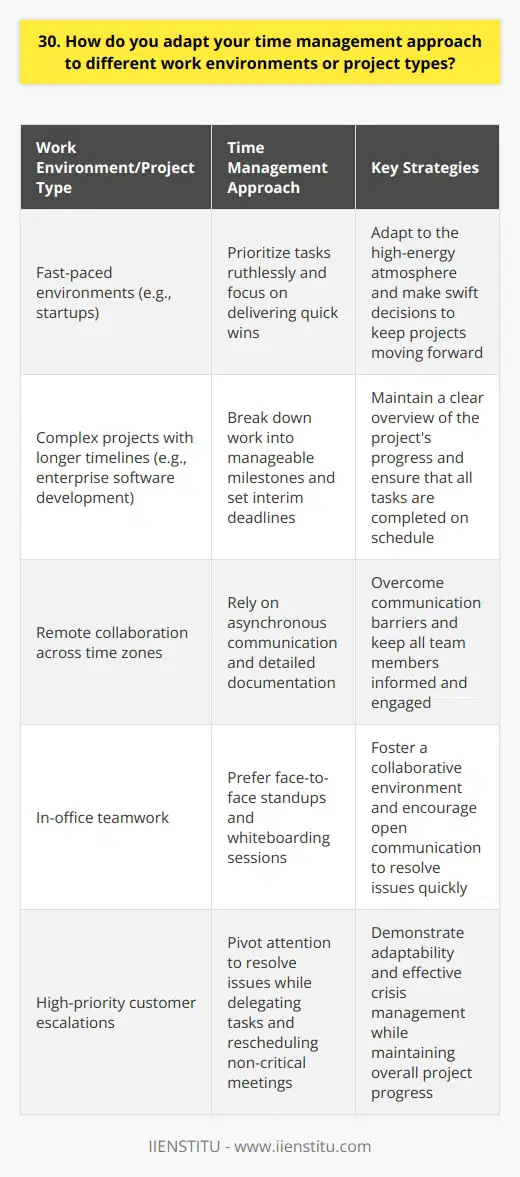
In today's fast-paced and demanding work environment, the question "What's your time management strategy for peak productivity?" has become increasingly relevant. Interviewers ask this question to gain insights into a candidate's ability to manage their time effectively, prioritize tasks, and achieve optimal productivity. As someone who has successfully navigated various roles and responsibilities, I have developed a comprehensive approach to time management that has proven to be highly effective in boosting my productivity and ensuring a healthy work-life balance.
One of the key elements of my time management strategy is prioritization. I firmly believe that not all tasks are created equal, and it is crucial to identify and focus on the most critical and time-sensitive tasks first. To achieve this, I employ the Eisenhower Matrix (Covey, 1989), a powerful tool that helps me categorize tasks based on their urgency and importance. By placing tasks into four quadrants - urgent and important, important but not urgent, urgent but not important, and neither urgent nor important - I can quickly determine which tasks require immediate attention and which ones can be delegated, deferred, or eliminated altogether.
For example, when I was working on a high-stakes project with a tight deadline, I used the Eisenhower Matrix to prioritize my tasks and ensure that I was focusing on the most critical aspects of the project. By doing so, I was able to deliver the project on time and exceed my manager's expectations, earning praise for my efficiency and attention to detail.
Long Tail Keyword Example: How To Answer Have You Used Analytics İn Logistics İnterview Question
Most Searched Prioritize Multiple Shipments İnterview Question
How To İntegrate Offline And Digital Marketing Strategies İn An İnterview
Another essential component of my time management strategy is the use of time blocking techniques. Time blocking involves allocating specific time slots for different tasks or activities, creating a structured and focused approach to work. By dedicating distinct periods to specific tasks, I can minimize distractions, improve concentration, and maximize my productivity. The Pomodoro Technique (Cirillo, 2006) is a particularly effective time blocking method that I often employ, breaking my work into 25-minute intervals (pomodoros) followed by short breaks. This technique helps me maintain a high level of focus and prevents burnout, as I know that I have a break to look forward to after each pomodoro.
Prioritization: Discuss how you prioritize your tasks based on the urgency and importance of the tasks, using the Eisenhower Matrix or other methods.
Time Block Technique: Talk about the Time Block technique, designating particular time slots in a day for different tasks, helping ensure focused work during those periods.
Use of Productivity Tools: Explain how tools like project management software, Google Calendar, etc., help you keep track of your tasks and deadlines.
Breaks: Express the importance of taking regular breaks to maintain focus and avoid burnout.
Limiting distractions: Discuss how you limit distractions during your work hours to maintain productivity.
Continuous Learning: Explain your appetite for learning new time management methods and productivity hacks to continuously improve.
I have found time blocking to be incredibly useful when working on complex projects that require deep concentration. By scheduling dedicated time blocks for research, writing, and editing, I can ensure that I am making steady progress without getting overwhelmed or sidetracked by less important tasks.
In addition to prioritization and time blocking, I also rely on a range of productivity tools to streamline my workflow and stay organized. Project management software like Trello and Asana helps me keep track of my tasks, deadlines, and collaborations with team members. These tools allow me to create detailed to-do lists, set reminders, and monitor my progress, ensuring that nothing falls through the cracks. Moreover, I use calendar apps like Google Calendar to schedule my time blocks and appointments, providing me with a clear overview of my day and helping me stay on track.
Can you describe your method for managing your time to achieve maximum productivity?
What techniques do you use to plan your time for optimum work productivity?
How do you arrange your schedule for highest performance?
What approach do you take to control your time and reach peak efficiency?
Could you explain your time management plan that results in greatest output?
What steps do you follow to manage your time for top performance?
In what way do you organize your time to drive high productivity?
Can you outline your time scheduling tactic for achieving the utmost productivity?
How do you apply time management techniques for enhancing workflow and productivity?
What's your strategy for distributing your time to reach the zenith of productivity?
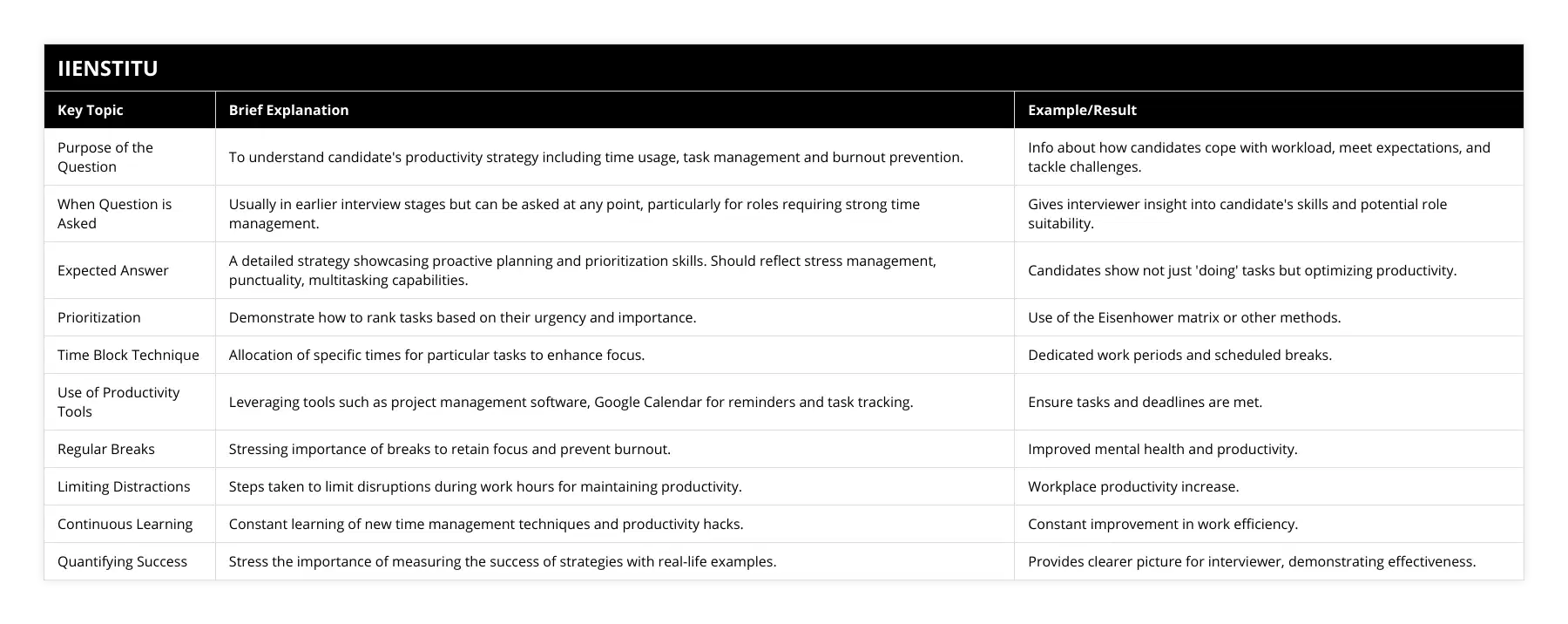
One of my favorite productivity tools is Evernote, a versatile note-taking app that allows me to capture ideas, create checklists, and store important information in a centralized location. By having all my notes and resources readily accessible, I can save time and maintain a clear focus on the task at hand.
While it may seem counterintuitive, taking regular breaks is another crucial aspect of my time management strategy. Research has shown that taking short breaks can actually boost productivity and creativity (Sio & Ormerod, 2009). By stepping away from my work for a few minutes every hour, I can recharge my mental batteries, reduce stress, and return to my tasks with renewed energy and focus. During my breaks, I often engage in simple activities like stretching, walking, or practicing mindfulness, which help me maintain a positive and balanced mindset throughout the day.
I recall a particularly challenging project where I was feeling overwhelmed and stuck. By incorporating regular breaks into my schedule, I was able to approach the project with fresh eyes and generate new ideas that ultimately led to a successful outcome.
Managing distractions is another key aspect of my time management strategy. In today's digital age, it's easy to get sidetracked by emails, social media notifications, and other interruptions. To minimize these distractions, I employ several techniques, such as:
1- Turning off notifications on my phone and computer during focused work sessions
2- Using website blockers to prevent access to distracting sites
3- Communicating my availability to colleagues and setting clear boundaries
4- Creating a dedicated workspace that is conducive to concentration
By implementing these techniques, I have been able to significantly reduce the amount of time I waste on unproductive activities and maintain a laser-like focus on my most important tasks.
Finally, I believe that continuous learning is essential for improving my time management skills and boosting my productivity. I make a point of regularly reading books, articles, and blogs on productivity, time management, and personal development. By staying up-to-date with the latest research and best practices, I can continuously refine my strategies and adapt to new challenges.
For instance, reading books like "Deep Work" by Cal Newport (2016) and "The 7 Habits of Highly Effective People" by Stephen Covey (1989) has provided me with invaluable insights and practical techniques for managing my time and achieving peak productivity. By applying the principles outlined in these books, I have been able to streamline my workflow, eliminate distractions, and focus on the tasks that matter most.
In conclusion, my time management strategy for peak productivity is a comprehensive approach that encompasses prioritization, time blocking, the use of productivity tools, regular breaks, managing distractions, and continuous learning. By employing these techniques, I have been able to consistently deliver high-quality work, meet deadlines, and maintain a healthy work-life balance. I believe that my success in previous roles can be largely attributed to my effective time management skills, and I am confident that I can bring this same level of efficiency and productivity to any future position.
Real-life examples, such as the high-stakes project I mentioned earlier, demonstrate the tangible impact that my time management strategy has had on my performance. By prioritizing tasks, using time blocking techniques, and leveraging productivity tools, I was able to navigate complex challenges and achieve outstanding results.
It's important to note that my time management strategy is not a one-size-fits-all approach. I understand that different individuals and roles may require different techniques and tools. However, by adopting a proactive, structured, and adaptable mindset, anyone can develop an effective time management strategy that works for them.
In today's competitive job market, being able to articulate your time management strategy is a valuable skill that can set you apart from other candidates. By providing a detailed and well-thought-out answer to the question "What's your time management strategy for peak productivity?", you can demonstrate to potential employers that you have the skills, knowledge, and experience necessary to excel in your role and contribute to the success of their organization.
So, the next time you find yourself in an interview, don't hesitate to share your time management strategy with confidence. By highlighting your prioritization skills, time blocking techniques, use of productivity tools, and commitment to continuous learning, you can showcase your ability to manage your time effectively and achieve peak productivity in any work environment.
References:
Cirillo, F. (2006). The Pomodoro Technique. FC Garage GmbH.
Covey, S. R. (1989). The 7 Habits of Highly Effective People. Simon & Schuster.
Newport, C. (2016). Deep Work: Rules for Focused Success in a Distracted World. Grand Central Publishing.
Sio, U. N., & Ormerod, T. C. (2009). Does incubation enhance problem solving? A meta-analytic review. Psychological Bulletin, 135(1), 94-120.
Frequently Asked Questions
1. How do you prioritize tasks to ensure maximum efficiency?
When prioritizing tasks, I focus on the most critical and time-sensitive items first. I assess each task's importance and urgency, then create a prioritized to-do list.
Assessing Importance and Urgency
To determine a task's priority level, I consider factors like deadlines, dependencies, and potential impact. Tasks with approaching due dates, those blocking other work, and high-impact items get moved to the top.
My Prioritization System
I've developed my own simple ranking method:
I review and adjust these priority buckets regularly as new tasks come in and circumstances change.
Staying Focused and Organized
Efficiency also requires focus and organization. I block off uninterrupted time for high-priority deep work. Keeping my workspace tidy and files organized saves valuable minutes every day.
The Power of Checklists
For complex projects, nothing beats a good old-fashioned checklist. Breaking deliverables down into component steps keeps me on track.
Overall, a bit of planning and conscious prioritization keeps me delivering maximum value and meeting key objectives. It's a simple system, but mastering the fundamentals makes all the difference.
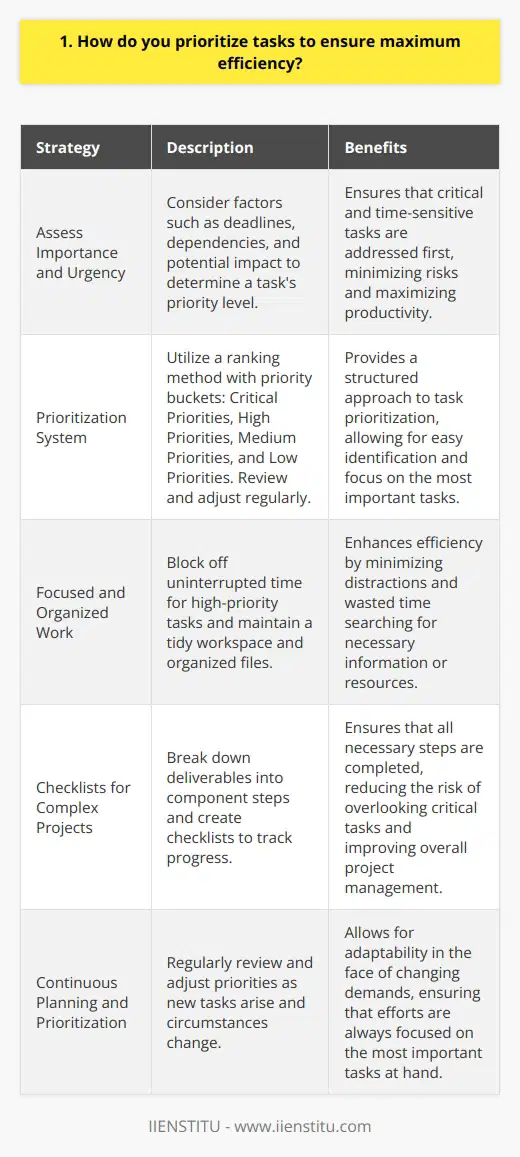
2. What techniques do you use to stay focused and avoid distractions?
Staying focused and avoiding distractions is essential for my productivity. Over the years, I've developed several techniques that help me stay on track.
Prioritizing Tasks
I start each day by prioritizing my tasks based on urgency and importance. This helps me focus on what matters most and avoid getting sidetracked by less critical tasks.
Breaking Down Projects
When working on larger projects, I break them down into smaller, manageable chunks. This makes the work feel less overwhelming and allows me to concentrate on one step at a time.
Minimizing Distractions
To minimize distractions, I create a focused work environment. I put my phone on silent, close unnecessary browser tabs, and use noise-canceling headphones when needed.
Taking Regular Breaks
I've found that taking short breaks every hour or so helps me maintain my focus. During these breaks, I stretch, grab a snack, or take a quick walk to refresh my mind.
Using Productivity Tools
I rely on productivity tools like Trello and Todoist to keep myself organized. These tools help me track my progress and ensure nothing falls through the cracks.
By implementing these techniques, I'm able to stay focused, avoid distractions, and deliver high-quality work consistently.
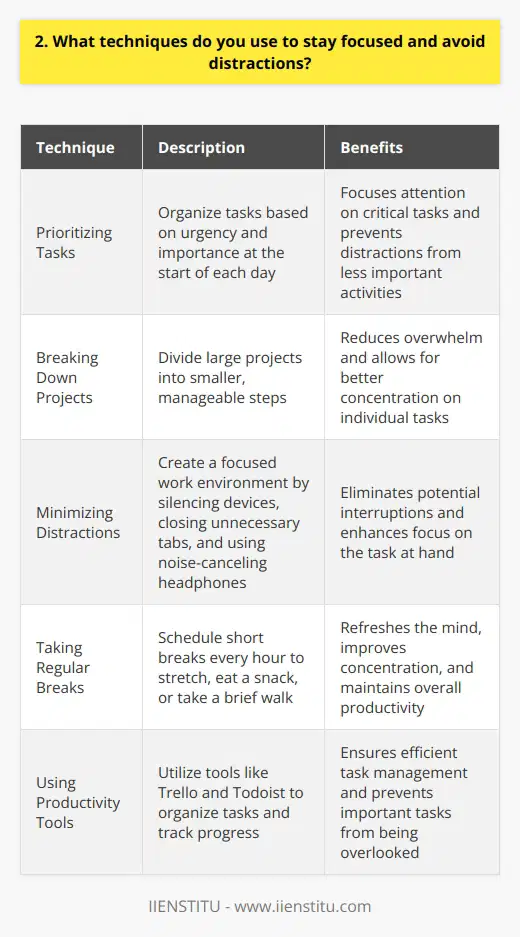
3. How do you handle unexpected interruptions or urgencies in your workday?
When unexpected interruptions or urgencies arise in my workday, I handle them calmly and efficiently. My approach is to quickly assess the situation and determine the best course of action.
Prioritizing Tasks
I prioritize the urgent matter and decide if it needs immediate attention or can wait a bit. If it's truly pressing, I'll put my current work on hold to address it right away.
For less critical interruptions, I'll make a note of what needs to be done and schedule it appropriately. This allows me to stay focused on my main priorities while still ensuring nothing falls through the cracks.
Communicating with the Team
Open communication is key when unexpected issues come up. I keep my team and manager informed about any changes to my workflow or schedule.
If I need to delegate tasks or get help from colleagues, I reach out promptly. We work together to find solutions and keep projects moving forward, even amid disruptions.
Staying Flexible and Adaptable
In my experience, interruptions and last-minute requests are just part of the job. I've learned to be flexible and adapt quickly to changing circumstances.
By staying organized, communicating clearly, and being willing to adjust my plans, I'm able to handle the unexpected with confidence. It's all about keeping a positive attitude and not getting flustered when things don't go exactly as planned.
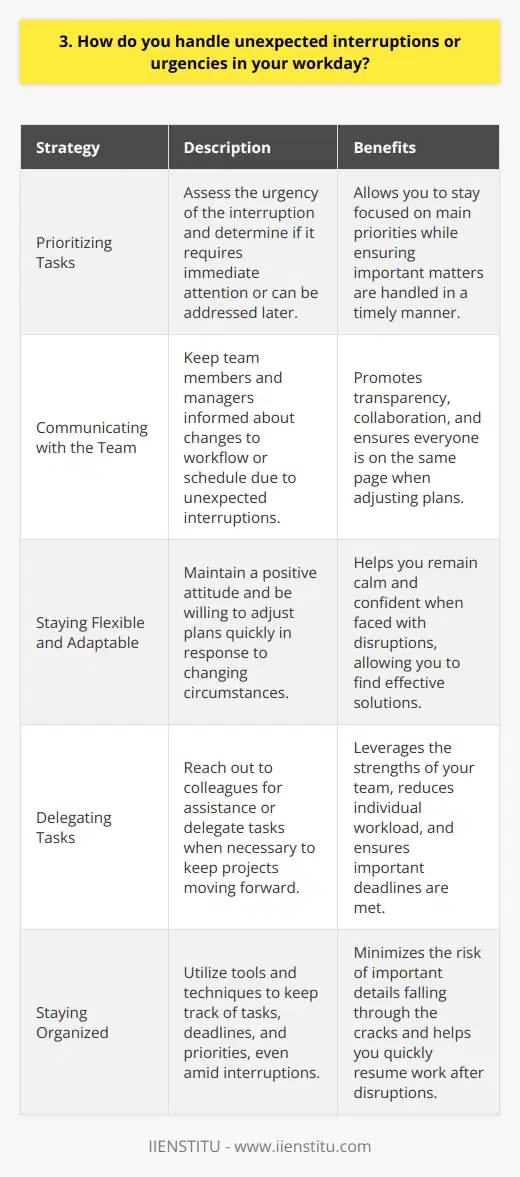
4. What tools or technologies do you utilize to manage your time effectively?
I utilize a combination of digital tools and traditional methods to effectively manage my time and stay organized. My go-to tool is my digital calendar, which I use to schedule all my tasks, meetings, and deadlines. I color-code each entry to quickly identify the type of activity and set reminders to keep me on track.
Prioritizing Tasks
In addition to my calendar, I use a task management app to prioritize my to-do list. I break down larger projects into smaller, manageable tasks and assign due dates to ensure I'm making steady progress. The app allows me to easily rearrange tasks based on urgency and importance.
Time Blocking
I'm a big believer in time blocking. I allocate specific time slots for different activities, such as responding to emails, working on projects, and taking breaks. This helps me stay focused and avoid getting sidetracked by less important tasks.
Pomodoro Technique
When I need to tackle a challenging task or maintain focus for an extended period, I use the Pomodoro Technique. I set a timer for 25 minutes and work without interruptions. After each Pomodoro, I take a short break to recharge. This method helps me maintain high productivity levels throughout the day.
Analog Tools
Despite relying heavily on digital tools, I still appreciate the value of analog methods. I always carry a small notebook with me to jot down ideas, thoughts, or tasks that come to mind. There's something satisfying about physically crossing off completed items from my list.
By leveraging these tools and techniques, I'm able to effectively manage my time, stay organized, and maintain a healthy work-life balance. I continuously assess and adapt my strategies to ensure they align with my goals and responsibilities.
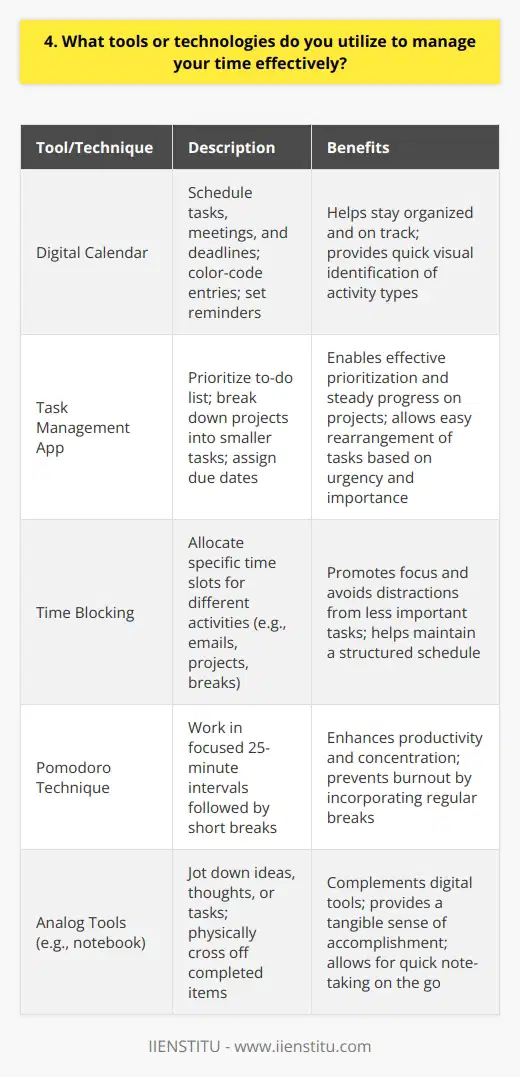
5. How do you balance competing priorities and deadlines?
When faced with competing priorities and deadlines, I rely on a few key strategies to stay on track. First, I take a step back and assess the big picture, considering the urgency and importance of each task. This helps me identify which items need my immediate attention and which can wait.
Prioritizing and Planning
Once I have a clear understanding of my priorities, I create a detailed plan of action. I break larger projects into smaller, manageable steps and set realistic deadlines for each milestone. This allows me to stay focused and avoid feeling overwhelmed by the overall scope of the work.
Effective Communication
Communication is key when juggling multiple responsibilities. I make sure to keep my team and stakeholders informed about my progress, any challenges I encounter, and potential adjustments to the timeline. By maintaining open lines of communication, I can ensure everyone is on the same page and working towards a common goal.
Adaptability and Flexibility
In my experience, priorities can shift unexpectedly, so I remain adaptable and flexible. If a new urgent task arises, I quickly reassess my plan and make necessary adjustments. I'm not afraid to ask for help or delegate tasks when needed to ensure everything gets done on time.
Continuous Improvement
Finally, I always take time to reflect on my performance and look for ways to improve my time management and organizational skills. Whether it's trying out a new productivity app or seeking advice from a mentor, I'm committed to finding better ways to balance competing demands and deliver high-quality work.
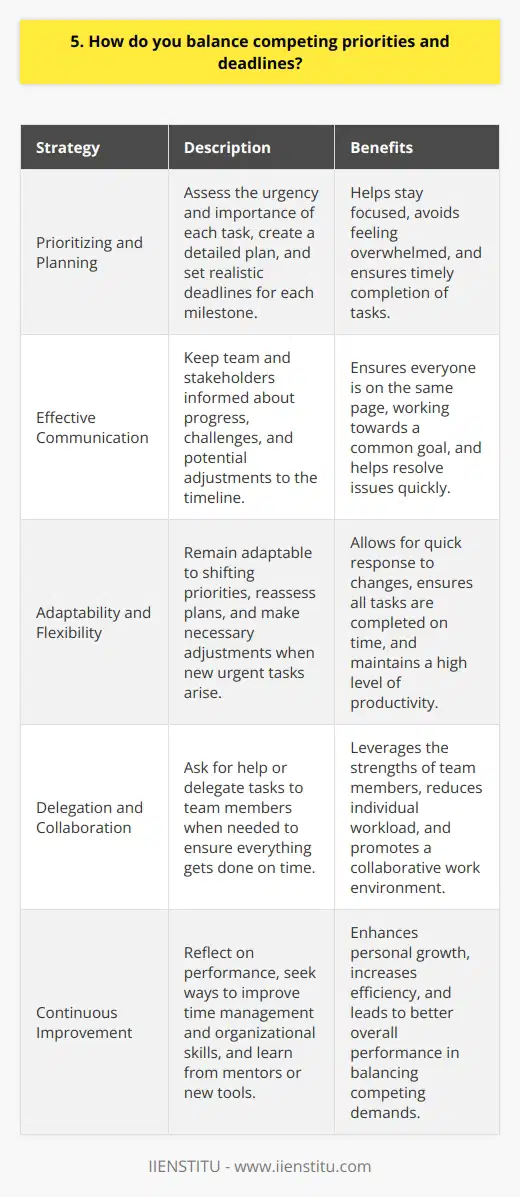
6. How do you ensure that you allocate sufficient time for high-value tasks?
I prioritize my tasks based on their importance and urgency. I create a to-do list every morning, ranking items from most to least critical. This helps me focus on what matters most and avoid getting sidetracked by less significant tasks.
Time Blocking
I use time blocking to allocate specific chunks of my day to high-priority tasks. By dedicating uninterrupted focus time, I can make meaningful progress on important projects and goals. I treat these blocks as non-negotiable appointments with myself.
Minimizing Distractions
During my focused work sessions, I eliminate distractions like notifications, emails, and social media. Putting my phone on silent and closing unnecessary browser tabs helps me stay in the flow. If colleagues have questions, I kindly let them know I'll get back to them later.
Regular Check-Ins
Throughout the day, I do quick check-ins to assess my progress and adjust as needed. If I'm falling behind on a critical task, I'll shift my priorities to get back on track. These check-ins keep me accountable and agile.
Saying No When Necessary
Sometimes I need to say no to requests that don't align with my top priorities. While I love helping my team, I've learned to politely decline when I need to stay focused on high-value work. Open communication ensures everyone understands.
By combining these strategies, I'm able to consistently devote quality time to the work that drives the most impact. It's an approach that has served me well in both my personal and professional life.
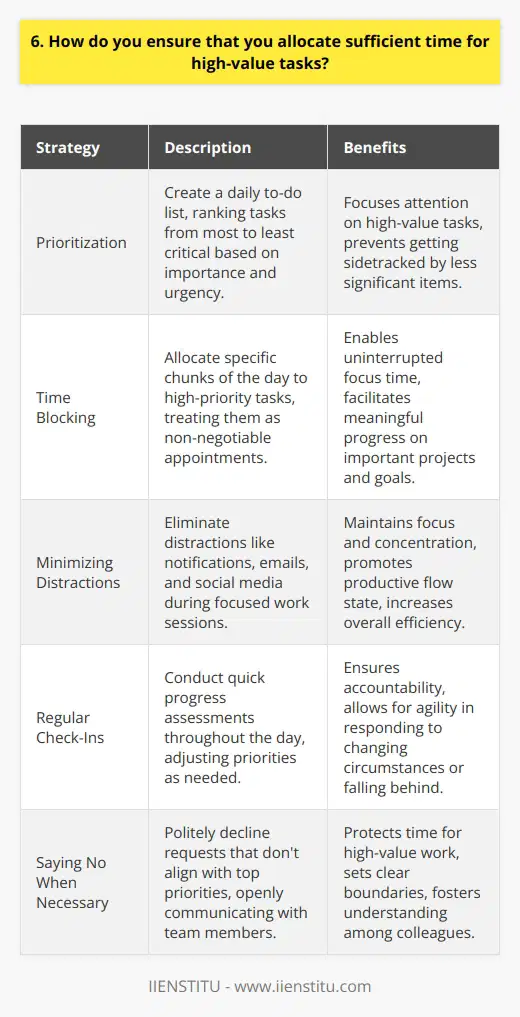
7. What strategies do you employ to prevent procrastination?
I employ several strategies to prevent procrastination and stay focused on my tasks. Firstly, I prioritize my work based on urgency and importance. This helps me tackle the most critical tasks first and avoid putting them off until later.
Setting Clear Goals and Deadlines
I set clear goals for each task and establish realistic deadlines. Having a specific target in mind keeps me motivated and accountable. I break down larger projects into smaller, manageable chunks, making them less overwhelming and easier to tackle.
Creating a Conducive Work Environment
I create a conducive work environment that minimizes distractions. I find a quiet space, put my phone on silent, and close unnecessary tabs on my computer. This helps me stay focused and avoid getting sidetracked by notifications or other interruptions.
Using Time Management Techniques
I use time management techniques like the Pomodoro Technique. I work in focused 25-minute intervals, followed by short breaks. This helps me maintain my concentration and prevents burnout. I also use time-blocking to allocate specific slots for different tasks, ensuring that I dedicate enough time to each one.
Staying Organized and Tracking Progress
I keep my workspace organized and use tools like to-do lists and calendars to track my progress. Seeing my tasks laid out visually helps me stay on top of my responsibilities and gives me a sense of accomplishment as I check items off my list.
By implementing these strategies consistently, I've been able to overcome procrastination and improve my productivity. It's an ongoing process, but I've found that being proactive and disciplined goes a long way in helping me achieve my goals.
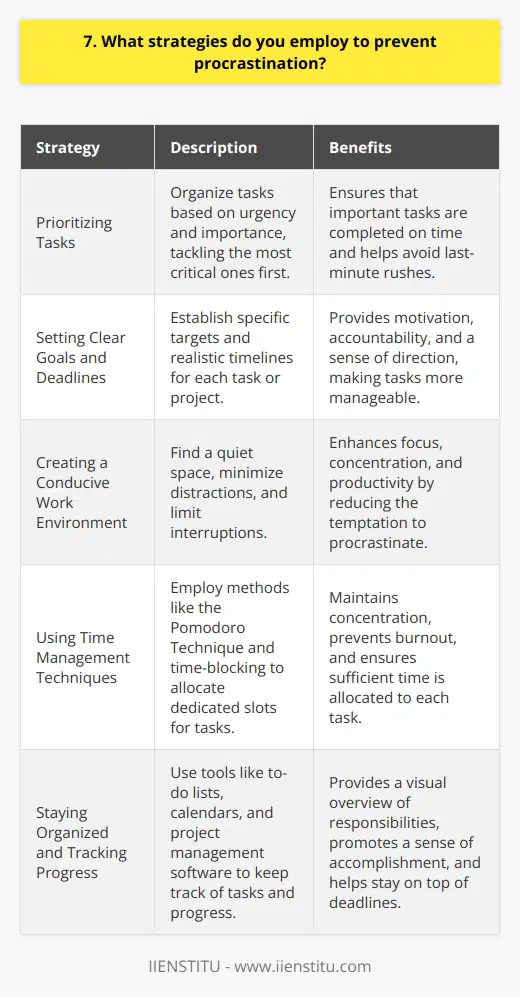
8. How do you manage your energy levels throughout the day to maintain productivity?
I manage my energy levels throughout the day by prioritizing tasks and taking regular breaks. In the morning, I focus on tackling the most important and challenging tasks when my energy is at its peak. I break down larger projects into smaller, manageable steps to avoid feeling overwhelmed.
Staying Hydrated and Nourished
Drinking water regularly and having nutritious snacks help me maintain steady energy levels. I always keep a water bottle on my desk as a reminder to stay hydrated. Eating a balanced lunch with a mix of proteins, healthy fats, and complex carbohydrates prevents the dreaded afternoon slump.
Taking Strategic Breaks
I've learned that taking short breaks throughout the day is crucial for recharging my batteries. When I feel my focus starting to drift, I step away from my desk for a few minutes. Sometimes I do some simple stretches, take a quick walk outside, or chat with a colleague. These brief moments of respite help me return to my tasks with renewed energy and a fresh perspective.
Prioritizing Self-Care
Outside of work, I prioritize self-care activities that contribute to my overall well-being. Getting enough sleep, exercising regularly, and engaging in hobbies I enjoy all play a role in maintaining my energy levels during the workday. When I take care of myself holistically, I find that I'm more resilient and better equipped to handle the demands of my job.
By being proactive about managing my energy levels, I'm able to stay focused, productive, and engaged throughout the day.
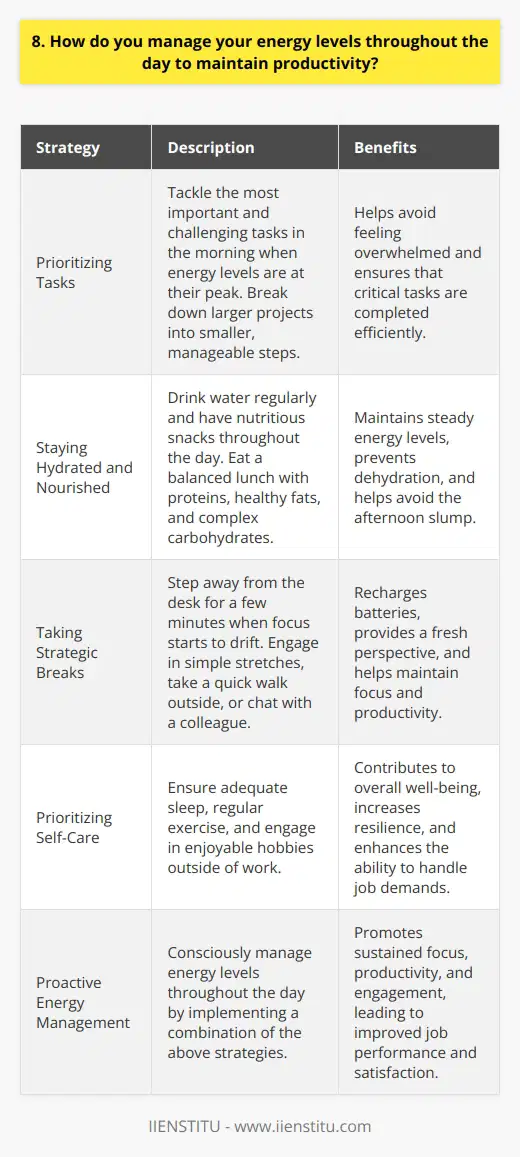
9. What methods do you use to break down large projects into manageable tasks?
When tackling large projects, I break them down into smaller, manageable tasks using a few key methods. First, I create a detailed outline that covers all the major components of the project. This helps me visualize the big picture and identify the essential steps needed to reach the end goal.
Prioritizing and Scheduling
Next, I prioritize the tasks based on their importance and dependencies. Some tasks may rely on others being completed first, so it's crucial to sequence them logically. I also consider the time and resources required for each task and allocate them accordingly in my schedule.
Breaking Down Complex Tasks
For particularly complex tasks, I break them down even further into subtasks. This makes them less overwhelming and allows me to focus on one small piece at a time. I find that this approach boosts my productivity and helps me maintain momentum throughout the project.
Regularly Reviewing Progress
As I work through the tasks, I regularly review my progress and adjust my plan if needed. Life is unpredictable, and sometimes unexpected challenges or opportunities arise. By staying flexible and adaptable, I can navigate these changes without losing sight of the ultimate goal.
Celebrating Milestones
Finally, I believe in celebrating the small victories along the way. Whenever I complete a significant task or reach a milestone, I take a moment to acknowledge my progress and recharge my motivation. These little celebrations remind me of how far I've come and give me the energy to tackle the next phase of the project with enthusiasm.
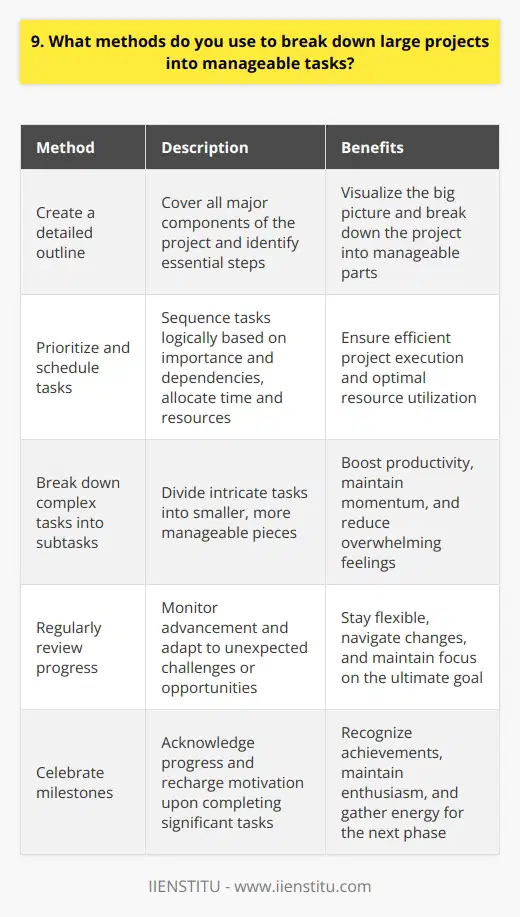
10. How do you handle the pressure of tight deadlines while maintaining quality?
I thrive under pressure and actually find that tight deadlines help me focus and work more efficiently. When faced with a looming deadline, I prioritize my tasks ruthlessly, zeroing in on the most critical items first. I break big projects down into smaller, manageable chunks and set mini milestones along the way.
Communicate and Collaborate
Open communication is key when working under pressure. I make sure to sync up regularly with my team, providing status updates and flagging any potential roadblocks early. Collaborating closely with colleagues allows us to troubleshoot issues and brainstorm solutions together.
Stay Organized Yet Flexible
Staying organized is a must when juggling competing priorities. I rely on my trusted system of to-do lists and project plans to keep me on track. At the same time, I've learned to stay nimble. Unexpected fires will inevitably flare up, and I've gotten good at quickly shifting gears to address the most pressing needs.
Keep Calm and Carry On
Most importantly, I try to keep calm and maintain perspective under pressure. Taking a few deep breaths helps me stay levelheaded so I can think through problems rationally rather than react out of stress. At the end of the day, I know that every challenge is an opportunity to stretch and grow. Tight deadlines have taught me to work smarter, not just harder. They've made me a better problem-solver and collaborator. While pressure can feel intense in the moment, I always try to step back and recognize how overcoming tough challenges helps me build resilience and expand my skill set in the long run.
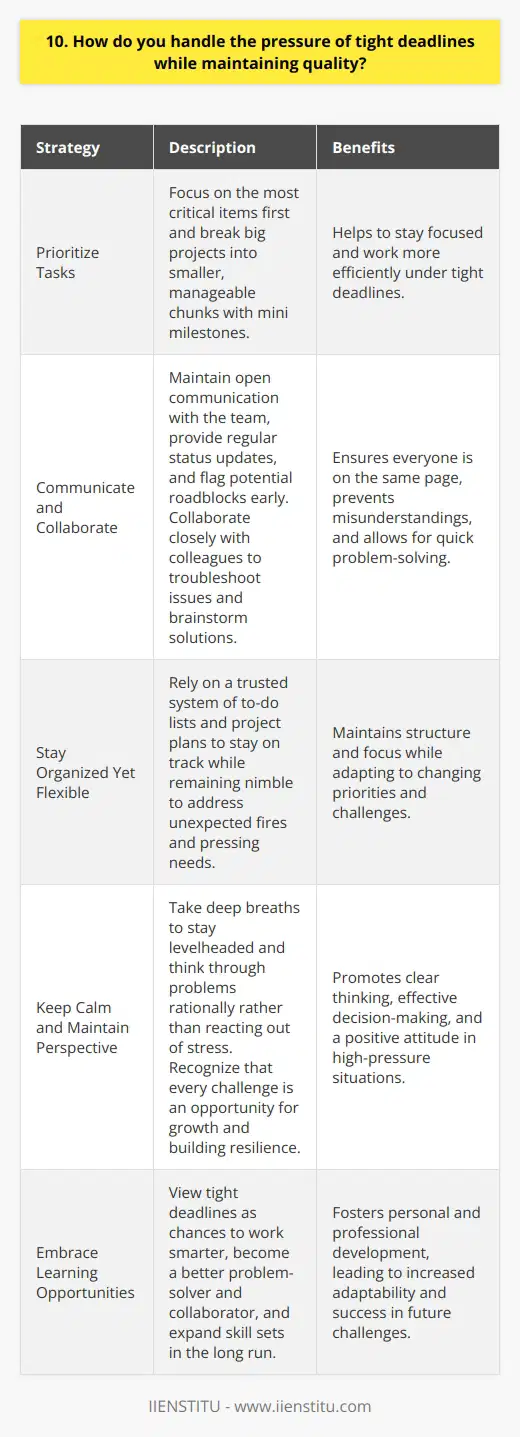
11. What's your approach to managing your time when working on multiple projects simultaneously?
When juggling multiple projects, I prioritize tasks based on deadlines and importance. This helps me stay organized and focused.
Effective Communication
I maintain open lines of communication with my team and stakeholders. Regular updates ensure everyone stays informed about progress and any issues that arise.
Flexibility is Key
Things don't always go according to plan, so I remain adaptable. If priorities shift, I adjust my schedule accordingly to keep projects on track.
Leveraging Technology
I'm a big believer in using the right tools for the job. Project management software helps me track tasks, collaborate with colleagues, and meet deadlines.
Taking Breaks
When I'm feeling overwhelmed, I find that stepping away for a few minutes can work wonders. A quick walk around the block or a chat with a coworker helps me recharge and refocus.
Celebrating Milestones
I think it's important to acknowledge progress along the way. When my team hits a milestone, we take a moment to celebrate before diving into the next phase.
At the end of the day, managing multiple projects comes down to staying organized, communicating effectively, and being willing to adapt as needed. It's not always easy, but with the right mindset and tools, it's definitely achievable.
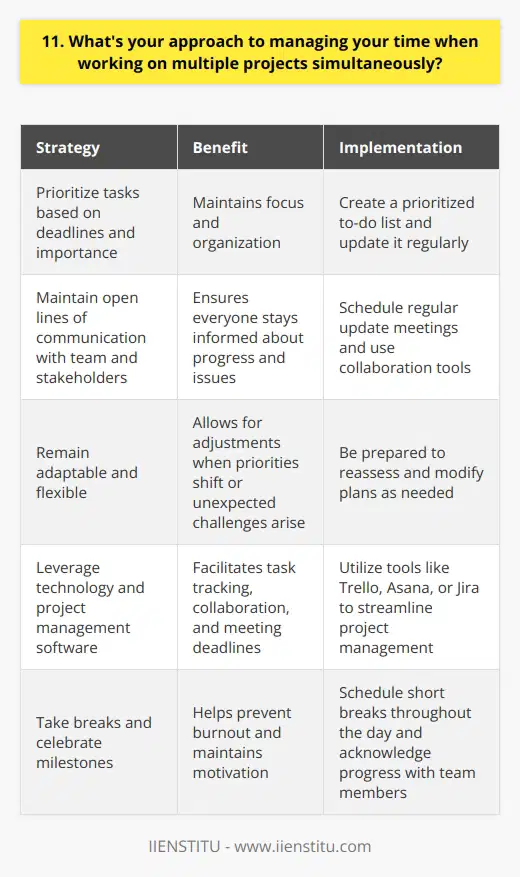
12. How do you incorporate breaks and self-care into your daily routine to avoid burnout?
I believe that incorporating breaks and self-care into my daily routine is crucial for maintaining productivity and avoiding burnout. I make it a point to take short breaks every hour or so to stretch, walk around, or simply rest my eyes. These brief moments of respite help me recharge and refocus on the task at hand.
Prioritizing Physical Well-being
In addition to taking regular breaks, I prioritize my physical well-being by ensuring that I get enough sleep each night and eat a balanced diet. I've found that when I'm well-rested and nourished, I'm better equipped to handle the challenges of the day.
Engaging in Hobbies and Interests
I also make time for activities that bring me joy and help me unwind, such as reading, painting, or spending time outdoors. Engaging in hobbies and interests outside of work helps me maintain a healthy work-life balance and prevents me from becoming overly stressed or burnt out.
Setting Boundaries and Communicating Needs
Finally, I believe in setting clear boundaries and communicating my needs to my colleagues and supervisors. If I'm feeling overwhelmed or need additional support, I don't hesitate to reach out and ask for help. By being proactive and taking care of myself, I'm able to bring my best self to work each day and contribute to a positive and productive work environment.
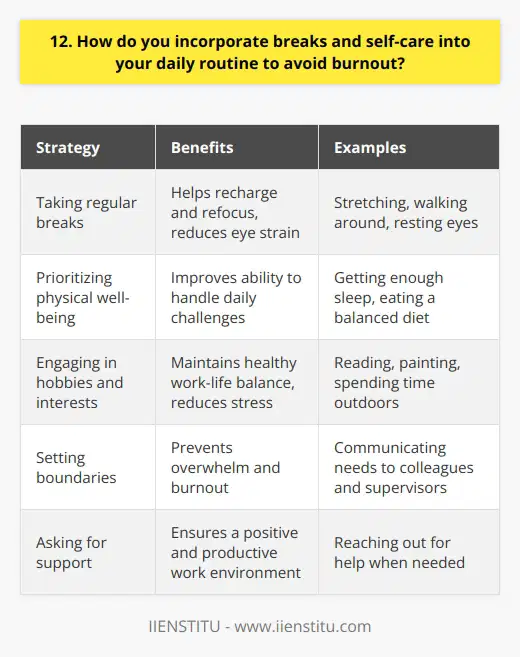
13. What techniques do you use to accurately estimate the time required for specific tasks?
When estimating the time required for specific tasks, I break them down into smaller, manageable components. This allows me to analyze each part individually and come up with a more accurate overall estimate.
Leveraging Past Experience
I draw upon my past experiences with similar tasks to gauge how long each component might take. For example, when I was working on a website redesign project last year, I recalled that the initial wireframing phase took about a week, so I used that as a baseline for estimating the wireframing time for a new project.
Accounting for Variables
I also consider any unique variables that could impact the timeline, such as the complexity of the task, the availability of resources, and potential roadblocks. I factor in a bit of buffer time to account for unexpected challenges that may arise.
Collaborating with the Team
When working on a team project, I collaborate with my colleagues to get their insights on the time required for their respective parts. We discuss any dependencies and ensure that our individual estimates align with the overall project timeline.
Continuous Refinement
As I progress through the task, I continuously refine my estimates based on the actual time taken for completed components. This helps me stay on track and adjust my estimates for the remaining work if needed.
By breaking down tasks, leveraging past experiences, accounting for variables, collaborating with the team, and continuously refining estimates, I can provide accurate time projections and ensure successful project delivery.
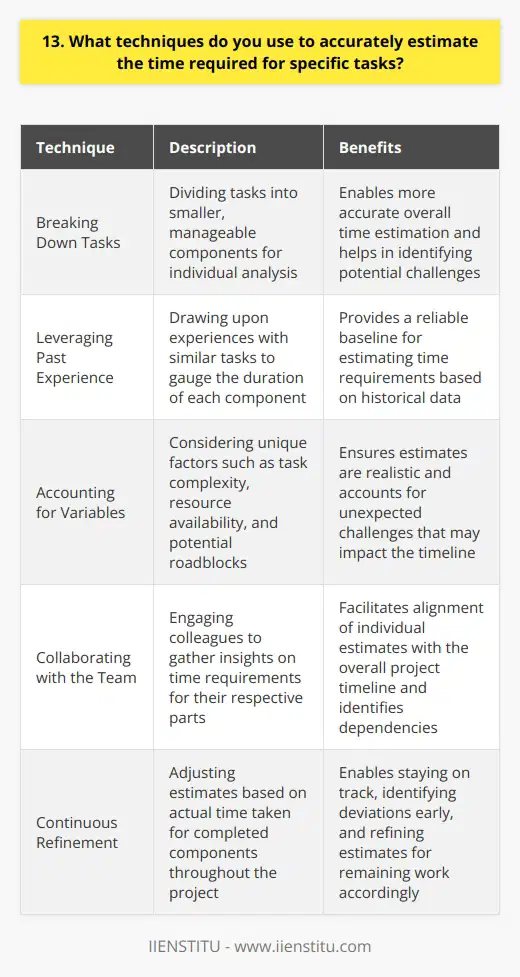
14. How do you adapt your time management strategy to accommodate changes in priorities?
As someone who thrives in fast-paced environments, I've learned that adaptability is key to effective time management. When priorities shift unexpectedly, I take a step back and reassess my task list to determine what needs immediate attention.
Communicate with the Team
I find that open communication with my team and supervisors is essential during these times. By discussing the changes and gathering input, we can collectively determine the best course of action and ensure everyone is on the same page.
Prioritize and Delegate
Once I have a clear understanding of the new priorities, I reorganize my tasks accordingly. I prioritize based on urgency and importance, tackling the most critical items first. If possible, I delegate tasks to team members with the appropriate skills and availability to help balance the workload.
Break Down Tasks
To avoid feeling overwhelmed, I break larger tasks into smaller, manageable steps. This allows me to focus on one piece at a time and make steady progress, even amidst the chaos of shifting priorities.
Stay Flexible and Positive
Throughout the process, I remain flexible and maintain a positive attitude. I've found that embracing change and viewing it as an opportunity for growth helps me stay motivated and productive. By being adaptable and proactive in my time management, I'm able to navigate shifts in priorities while still delivering high-quality work.
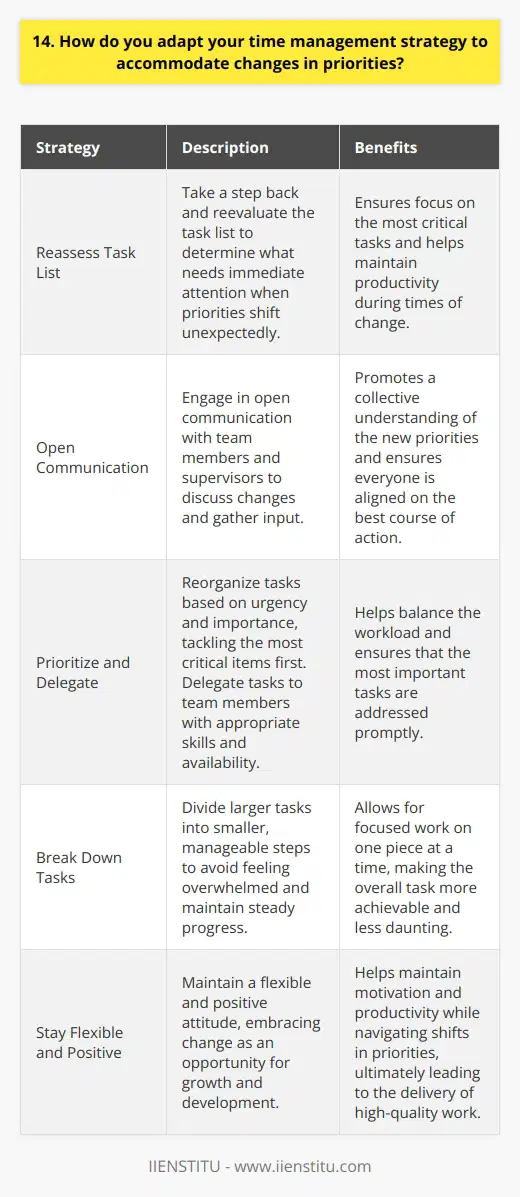
15. What's your method for tracking progress and ensuring that you stay on schedule?
I have a few methods for tracking progress and ensuring that I stay on schedule. First and foremost, I break down large projects into smaller, manageable tasks. This allows me to focus on one step at a time and not get overwhelmed by the bigger picture.
Setting Realistic Deadlines
I'm a big believer in setting realistic deadlines for each task. I look at my calendar, consider my current workload, and give myself a reasonable amount of time to complete each item. If I'm not confident I can meet a deadline, I communicate that upfront to manage expectations.
Utilizing Project Management Tools
I also rely heavily on project management tools like Trello and Asana. These platforms help me visualize my progress, collaborate with team members, and ensure nothing falls through the cracks. I update my tasks daily and use the built-in reminders to keep myself accountable.
Regular Check-Ins
Another key component of my method is regular check-ins. I touch base with my manager or client at least once a week to provide updates, discuss any roadblocks, and make sure we're aligned on priorities. This open communication helps prevent misunderstandings and keeps projects moving forward.
Flexibility and Adaptability
Finally, I try to remain flexible and adaptable. Sometimes unexpected issues arise or priorities shift. When that happens, I reassess my task list, communicate any changes to the timeline, and pivot as needed to keep things on track.
At the end of the day, it's all about finding a system that works for you and your team. I'm always looking for ways to optimize my methods and be as productive as possible.
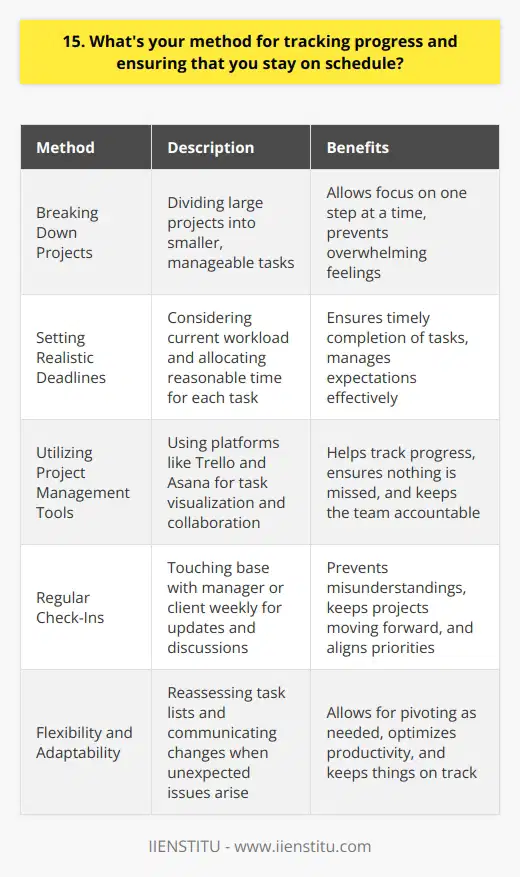
16. How do you handle situations where you have more tasks than available time?
When faced with more tasks than available time, I prioritize my workload based on urgency and importance. I communicate openly with my team and supervisors about my capacity and seek their input on priorities.
Strategies for Managing a Heavy Workload
I'm a firm believer in working smarter, not just harder. Some tactics I employ:
Keeping Calm Under Pressure
When the heat is on and deadlines are looming, I take a deep breath and focus on solutions rather than stress. Staying level-headed helps me think clearly and get more done. If I start feeling overwhelmed, I'll step away for a quick walk to clear my head and regain perspective.
The Upside of Challenging Situations
I actually appreciate having a full plate at times - it pushes me to be efficient, creative, and grow my time management skills. Overcoming a daunting to-do list gives me a real sense of accomplishment at the end of the day. And successfully juggling competing priorities demonstrates my dependability to my team.
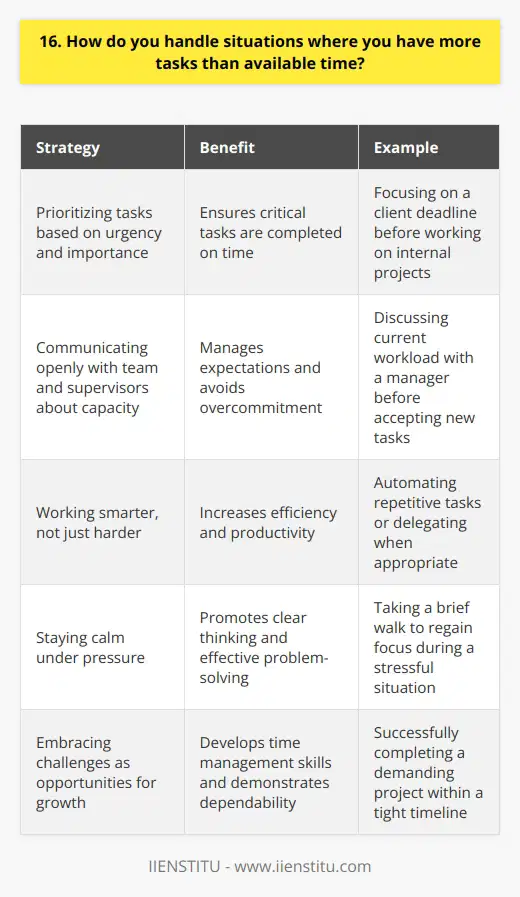
17. What strategies do you use to minimize the impact of meetings on your productivity?
I use several strategies to minimize the impact of meetings on my productivity. First, I prioritize and only attend essential meetings. Before accepting an invitation, I consider if my presence is truly necessary and valuable.
Preparing in Advance
When I do attend meetings, I come prepared. I review the agenda beforehand and gather any needed materials or information. This allows me to participate efficiently and keeps the meeting focused and on track.
Scheduling Techniques
I'm also strategic about when I schedule meetings. I try to cluster them together to avoid constant interruptions throughout the day. For example, I might designate certain afternoons as "meeting blocks" to protect my most productive morning hours.
Staying Focused and Engaged
During the meeting itself, I stay focused and engaged. I take notes, ask questions, and contribute relevant ideas. Active participation helps me absorb the key takeaways quickly, so I can jump back into my work afterwards.
Following Up Efficiently
After the meeting ends, I take a moment to review my notes and identify any action items or next steps. I update my to-do list right away so important tasks don't slip through the cracks.
Protecting Deep Work Time
Finally, I fiercely protect blocks of uninterrupted "deep work" time for tackling my most cognitively-demanding tasks. I treat these focused sessions as sacred and avoid scheduling any meetings during these periods whenever possible.
By being intentional about which meetings I attend and how I engage in them, I can minimize their impact on my overall productivity. It's an ongoing balancing act, but these strategies help me make the most of my time and energy.
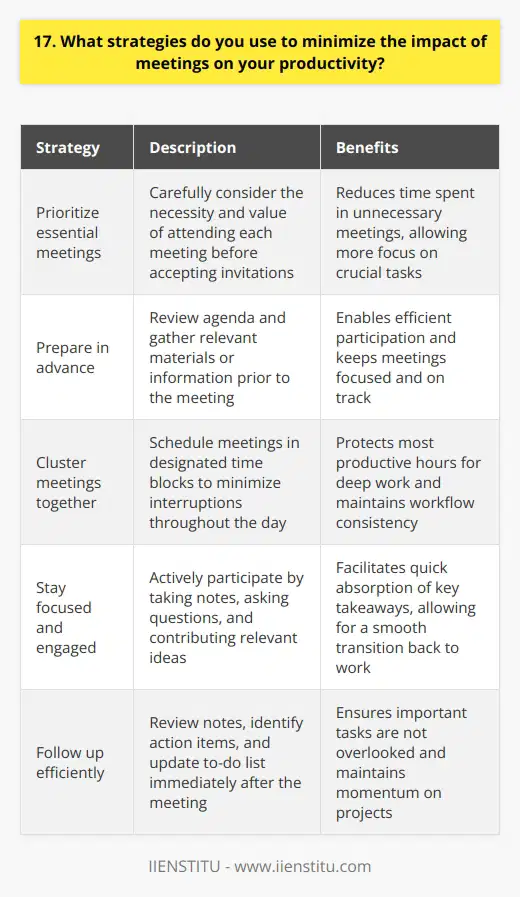
18. How do you leverage delegation to optimize your time and focus on high-priority tasks?
As a manager, I understand the importance of effective delegation in optimizing my time and focusing on high-priority tasks. Over the years, I've developed a system that allows me to delegate tasks efficiently while ensuring that my team members have the support they need to succeed.
Identifying Tasks for Delegation
The first step in leveraging delegation is to identify tasks that can be delegated. I review my to-do list regularly and ask myself, "Is this a task that someone else on my team could handle?" If the answer is yes, I consider delegating it.
Matching Tasks with Team Members
Once I've identified tasks for delegation, I think carefully about which team member is best suited for each task. I consider their skills, experience, and workload to ensure that they have the capacity to take on the task and complete it successfully.
Providing Clear Instructions and Expectations
When delegating a task, I provide clear instructions and expectations. I explain the task, the desired outcome, and any deadlines or constraints. I also make sure that the team member has the resources and support they need to complete the task.
Following Up and Providing Feedback
After delegating a task, I follow up regularly to ensure that the team member is making progress and to provide any necessary guidance or support. Once the task is complete, I provide feedback to help the team member learn and grow.
The Benefits of Effective Delegation
By leveraging delegation effectively, I'm able to focus on high-priority tasks that require my attention while also empowering my team members to take on new challenges and develop their skills. This not only optimizes my time but also helps to build a strong, capable team.
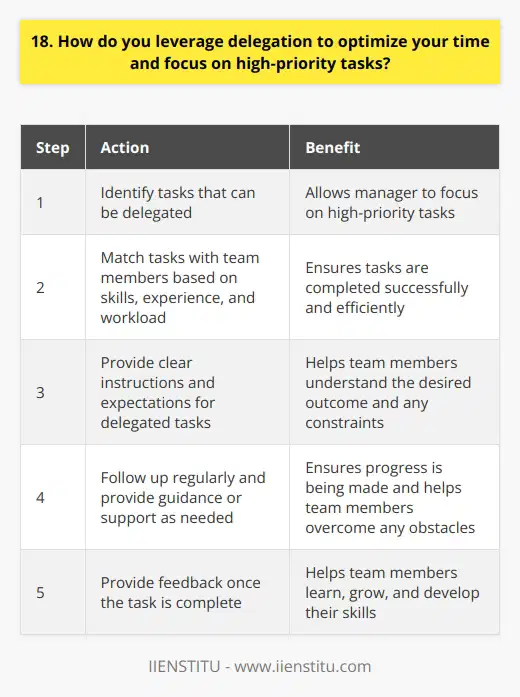
19. What techniques do you employ to maintain a healthy work-life balance?
Maintaining a healthy work-life balance is crucial for both personal well-being and professional success. Over the years, I've developed several techniques that help me achieve this balance.
Setting Clear Boundaries
One of the most important things I do is set clear boundaries between work and personal life. When I'm at work, I focus fully on my job responsibilities and give my best effort. However, once I leave the office or log off for the day, I make a conscious effort to disconnect from work-related tasks and enjoy my personal time.
Prioritizing Self-Care
I believe that taking care of myself is essential for maintaining a healthy work-life balance. I make sure to prioritize activities that promote my physical, mental, and emotional well-being. This includes regular exercise, healthy eating habits, and engaging in hobbies that bring me joy and relaxation.
Effective Time Management
To ensure that I have enough time for both work and personal commitments, I employ effective time management strategies. I create to-do lists, prioritize tasks based on urgency and importance, and break larger projects into smaller, manageable steps. By being organized and efficient with my time at work, I can free up more time for personal pursuits outside of work hours.
Communicating with Colleagues and Loved Ones
Open communication is key to maintaining a healthy work-life balance. I make sure to communicate my needs and expectations clearly with my colleagues and supervisors. If I have personal commitments that require me to leave work early or take time off, I discuss it with my team in advance to ensure that everyone is on the same page. Similarly, I communicate openly with my loved ones about my work schedule and make an effort to be fully present when spending time with them.
By implementing these techniques consistently, I have been able to maintain a healthy work-life balance that allows me to thrive both professionally and personally. It's an ongoing process that requires flexibility and adaptability, but I believe it's essential for long-term success and happiness.
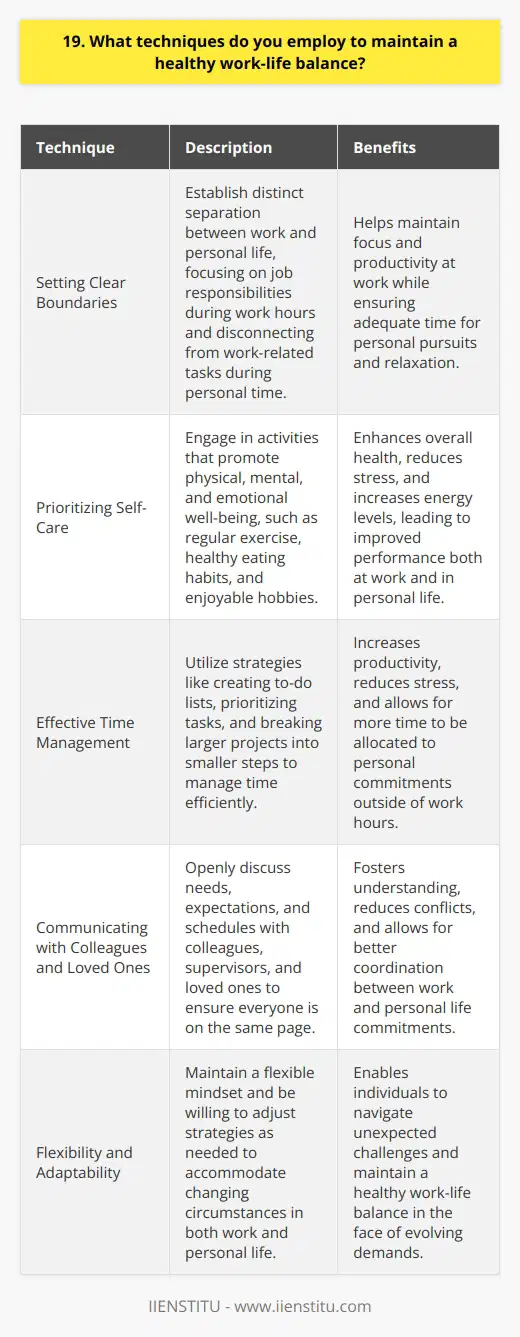
20. How do you use goal-setting to guide your time management and productivity?
I believe that effective goal-setting is crucial for managing my time and maximizing productivity. I start by defining clear, specific objectives that align with my overall career aspirations. These goals serve as a roadmap, guiding my daily activities and helping me prioritize tasks.
Breaking Down Goals
To make my goals more manageable, I break them down into smaller, actionable steps. This allows me to focus on one thing at a time and avoid feeling overwhelmed. I set deadlines for each milestone, which creates a sense of urgency and motivation.
Prioritizing Tasks
With my goals in mind, I prioritize my tasks based on their importance and urgency. I tackle the most critical and time-sensitive items first, ensuring that I make steady progress toward my objectives. This approach helps me avoid procrastination and stay on track.
Monitoring Progress
I regularly monitor my progress to ensure that I'm staying on course. If I encounter obstacles or fall behind, I reassess my strategy and make adjustments as needed. Celebrating small wins along the way keeps me motivated and reinforces the value of goal-setting.
Staying Flexible
While having well-defined goals is essential, I also remain flexible and open to new opportunities. If a project or task arises that aligns with my overall objectives, I'm willing to adapt my plan accordingly. This flexibility allows me to seize valuable chances for growth and development.
In summary, goal-setting is a powerful tool that I use to guide my time management and productivity. By setting clear objectives, breaking them down into manageable steps, prioritizing tasks, monitoring progress, and staying flexible, I'm able to consistently achieve strong results and advance in my career.
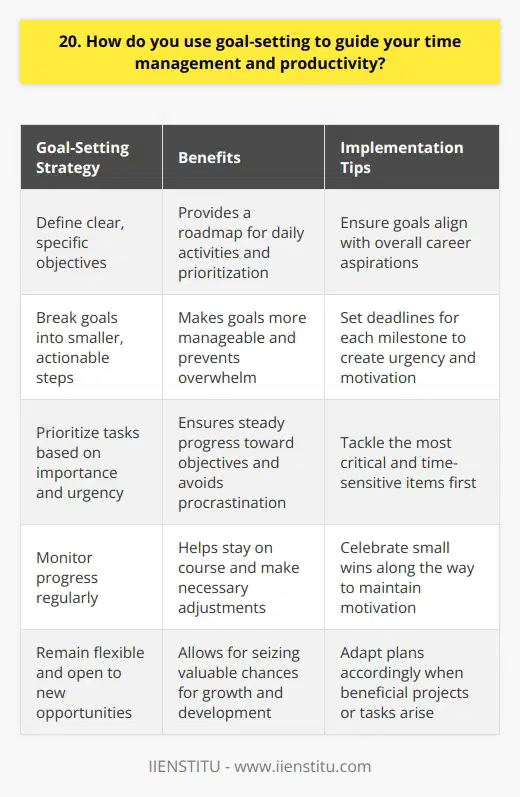
21. What's your approach to managing your email and other forms of communication efficiently?
When it comes to managing my email and other forms of communication, I have a few key strategies that help me stay organized and efficient.
Prioritizing Messages
First, I prioritize my messages based on urgency and importance. I quickly scan my inbox and respond to time-sensitive emails first. This ensures that nothing falls through the cracks and that I'm addressing the most critical issues promptly.
Folders and Labels
I also make use of folders and labels to categorize my emails. This helps me find specific messages easily when I need to refer back to them. I have separate folders for different projects, clients, or topics, which keeps my inbox clutter-free and allows me to focus on one thing at a time.
Scheduled Check-Ins
Another approach I take is scheduling regular check-ins with my email. Instead of constantly monitoring my inbox throughout the day, which can be distracting, I set aside specific times to review and respond to messages. This helps me stay focused on other tasks without interruptions.
Clear and Concise Communication
When it comes to crafting my own messages, I strive for clarity and conciseness. I aim to convey my points effectively while being mindful of the recipient's time. I use clear subject lines, keep my messages brief, and highlight any action items or key information.
Other Communication Channels
In addition to email, I'm comfortable using various other communication channels, such as instant messaging, project management tools, or video conferencing, depending on the situation and the team's preferences. I adapt to the tools that facilitate efficient collaboration and keep everyone on the same page.
Overall, my approach to managing email and communication is centered around organization, prioritization, and clarity. By staying on top of my inbox, categorizing messages, and communicating effectively, I ensure that nothing gets overlooked and that I'm able to collaborate smoothly with my colleagues and clients.
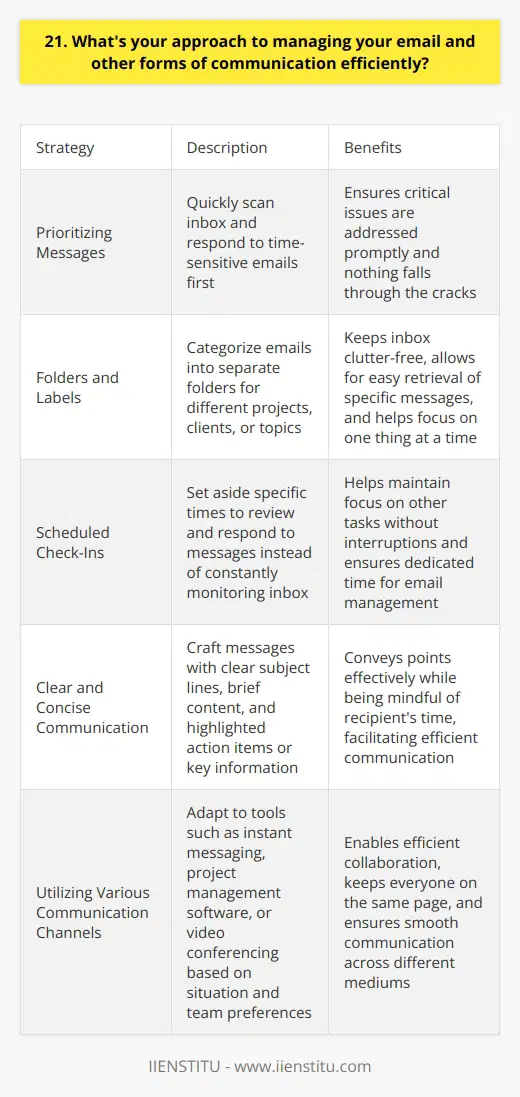
22. How do you handle tasks that you find challenging or less enjoyable?
When faced with challenging or less enjoyable tasks, I approach them with a positive and determined mindset. I break the task down into smaller, manageable steps to make it feel less overwhelming.
Prioritize and Plan
I prioritize the task based on its importance and deadline. Then, I create a plan of action, setting realistic goals and timelines for each step. This helps me stay organized and focused.
Seek Help and Resources
If I encounter difficulties, I'm not afraid to ask for help or guidance from colleagues or supervisors. I also research and utilize available resources to gain a better understanding of the task at hand.
Find Motivation and Rewards
To stay motivated, I remind myself of the value and purpose behind the task. I also set small rewards for myself upon completing each step, which keeps me engaged and driven.
Learn and Grow
I view challenging tasks as opportunities for personal and professional growth. By tackling them head-on, I develop new skills, gain valuable experience, and become a more versatile employee.
In the end, I take pride in my ability to overcome obstacles and deliver quality work, regardless of the task's nature. I believe that with the right approach and mindset, any challenge can be conquered.
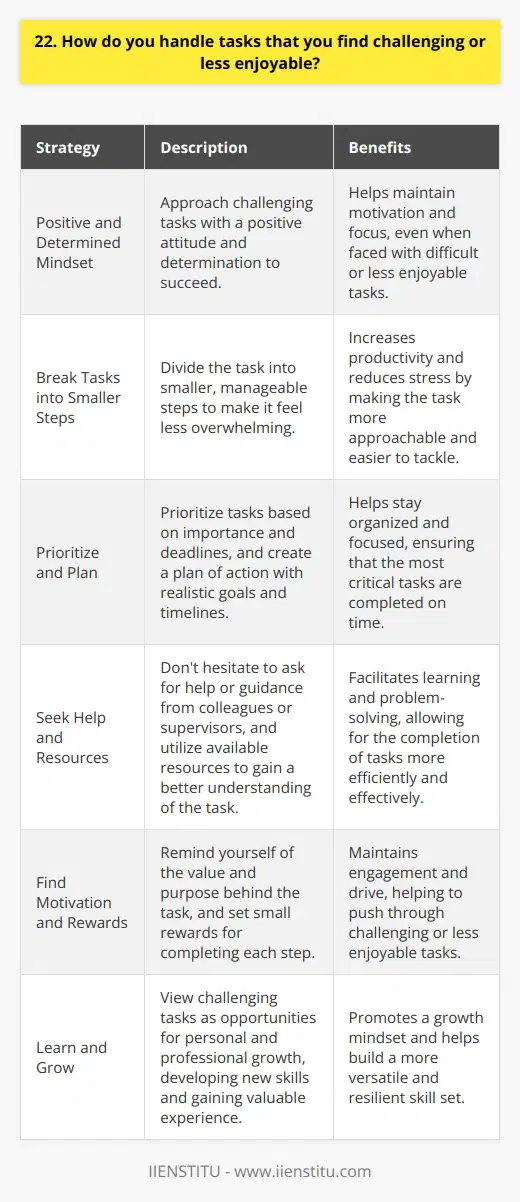
23. What methods do you use to stay organized and keep your workspace clutter-free?
I have developed a few key strategies to keep my workspace organized and clutter-free. First and foremost, I make a habit of tidying up at the end of each day. I put away any loose papers, file important documents, and dispose of anything I no longer need. This daily reset helps me start each morning with a clean slate.
Prioritizing Digital Organization
In today's digital age, a significant portion of my work is done on the computer. I've found that keeping my digital files and folders well-organized is just as important as maintaining a tidy physical workspace. I use a clear naming convention for my files and folders, making it easy to locate what I need quickly. I also regularly backup my work to the cloud to ensure nothing gets lost.
Utilizing Tools and Systems
I'm a big believer in using the right tools for the job. I rely on a combination of a physical planner and digital task management software to keep track of my to-do list and deadlines. For larger projects, I break them down into smaller, manageable tasks and schedule them out over time. This helps me avoid feeling overwhelmed and ensures that nothing falls through the cracks.
Encouraging a Clutter-Free Culture
Finally, I try to encourage a clutter-free culture in my workspace. If I'm working on a team, I suggest implementing a "clean desk policy" where everyone tidies up their space at the end of the day. I find that when everyone is committed to maintaining an organized environment, it's much easier to stay on top of clutter.
By implementing these strategies, I'm able to maintain a highly organized and efficient workspace. This allows me to focus on my work without distractions and be as productive as possible.
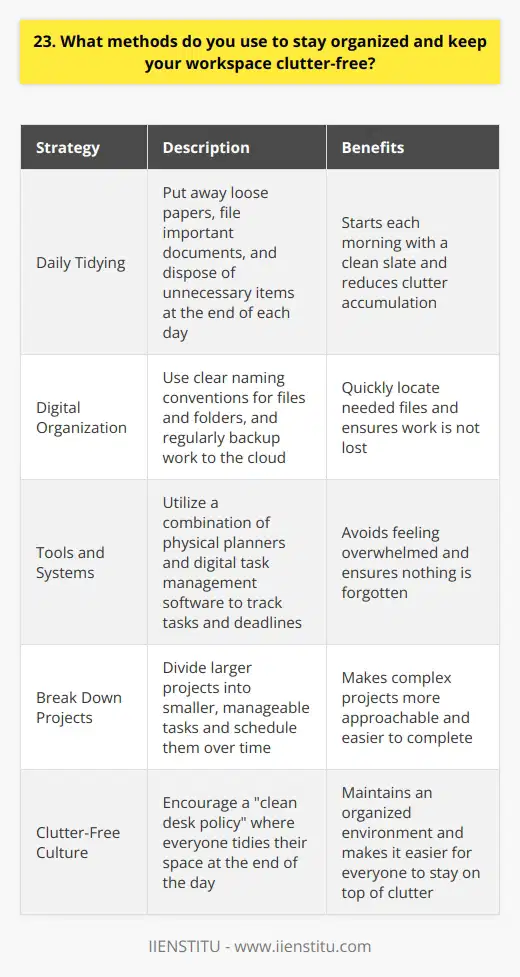
24. How do you incorporate learning and skill development into your time management strategy?
I prioritize learning and skill development by setting aside dedicated time for it in my schedule. Each week, I block off a few hours specifically for training, courses, or practicing new skills. This ensures that I consistently make progress and don't let other tasks overshadow my growth.
Maximizing Downtime
I also look for opportunities to learn during my commute or lunch breaks. Listening to podcasts or reading industry blogs helps me stay up-to-date without taking extra time. If I have a few minutes between meetings, I'll often skim an article or review my notes from a course.
Aligning Learning with Goals
When deciding what skills to focus on, I consider both my short-term projects and long-term career aspirations. If there's a new technology that would help with an upcoming deliverable, I'll prioritize getting familiar with it. But I also think about where I want to be in 5 years and gradually build expertise in those areas.
Collaborating with Colleagues
Some of my most valuable learning experiences have come from collaborating with coworkers who have different specializations. I make a point to schedule brainstorming sessions or pair programming time with teammates I can learn from. Teaching others is also a great way to deepen my own understanding.
Applying New Skills
Whenever possible, I try to apply new concepts to real projects soon after learning them. Putting skills into practice right away helps cement my understanding. I've found that I retain far more when I use the information, rather than just reading or watching.
By being strategic and proactive, I'm able to keep developing my skills while still delivering high-quality work on time. Continuous growth energizes me and allows me to tackle exciting new challenges as they arise.
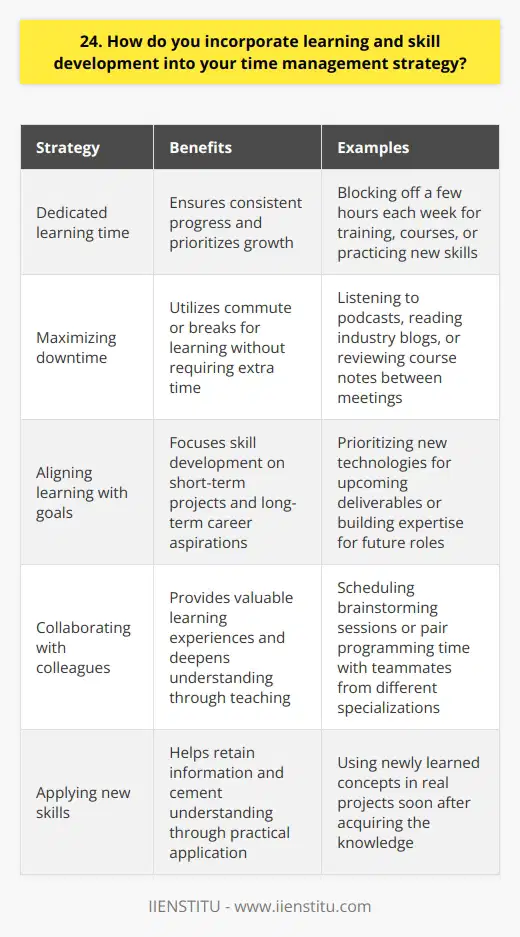
25. What techniques do you use to manage stress and maintain a positive mindset?
I have developed several techniques to effectively manage stress and maintain a positive mindset in my professional life:
Prioritizing Self-Care
I make sure to prioritize self-care activities like regular exercise, healthy eating, and getting enough sleep. These habits help me feel energized and better equipped to handle challenges.
Last year, I started practicing yoga three times a week before work. It's been an incredible stress reliever and helps me approach the day with a calm, centered perspective.
Focusing on Solutions
When faced with stressful situations, I try to focus on finding solutions rather than dwelling on the problems. I break down complex issues into manageable steps and tackle them one at a time.
In my previous role, we faced a tight project deadline that initially seemed overwhelming. By concentrating on actionable solutions and rallying the team, we delivered impressive results without burning out.
Cultivating a Support Network
I've learned the importance of cultivating a strong support network both within and outside of work. Having trusted colleagues, mentors, friends, and family to turn to helps me maintain perspective and stay positive.
I'm grateful for the relationships I've built over the years. Whether it's brainstorming with a coworker or venting to a friend over coffee, these connections are invaluable for managing stress.
Practicing Mindfulness
Incorporating mindfulness techniques like deep breathing and meditation helps me stay grounded and focused. Even a few minutes of mindful practice can make a big difference in my stress levels and outlook.
I've found that taking short mindfulness breaks throughout the day, especially before important meetings or presentations, helps me approach challenges with greater clarity and composure.
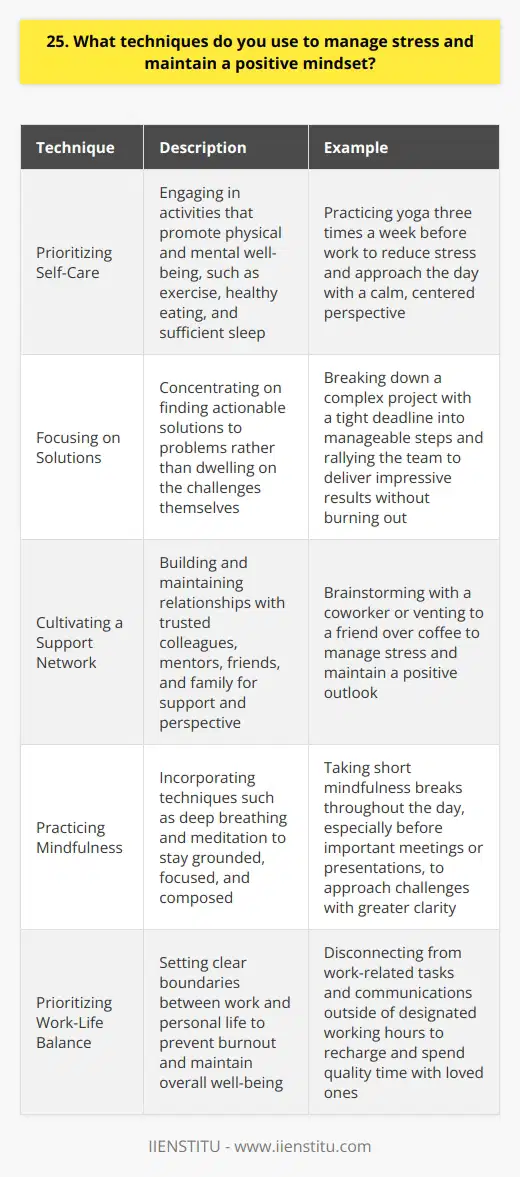
26. How do you prioritize self-reflection and continuous improvement in your time management practices?
I believe that self-reflection and continuous improvement are essential for effective time management. I set aside dedicated time each week to review my progress and identify areas for growth. By regularly assessing my strengths and weaknesses, I can make targeted adjustments to my approach.
Learning from Successes and Failures
I find it valuable to analyze both my successes and failures. When things go well, I consider what strategies or habits contributed to that outcome. Similarly, when I fall short of my goals, I try to pinpoint the underlying causes. Did I underestimate the time required for a task? Did I get sidetracked by less important activities? By asking myself these questions, I gain insights that inform my future planning.
Seeking Feedback and Advice
In addition to self-reflection, I actively seek feedback from colleagues and mentors. Their perspectives often illuminate blind spots in my time management practices. I'm grateful when someone points out an inefficiency in my workflow or suggests a helpful productivity tool. Incorporating their advice has led to some of my biggest improvements over the years.
Embracing Experimentation
I also prioritize continuous improvement by embracing experimentation. I'm always on the lookout for new time management techniques and technologies. While not every approach works for me, I've discovered some game-changing strategies by keeping an open mind. Whether it's time blocking, the Pomodoro Technique, or using project management software, I'm willing to test different methods to optimize my productivity.
Ultimately, I believe that self-reflection and continuous improvement are ongoing processes. I'm committed to refining my time management skills throughout my career. By staying introspective and adaptable, I aim to make the most of every minute.
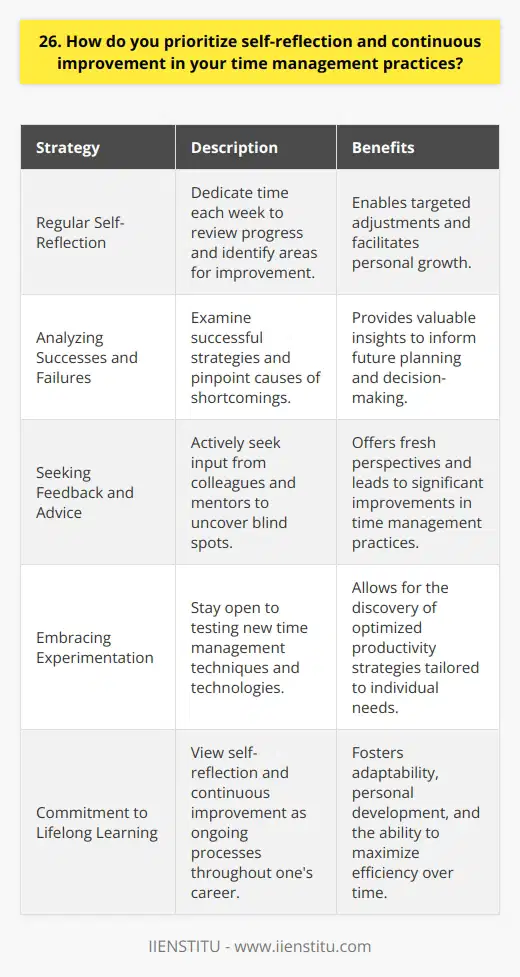
27. What strategies do you employ to collaborate effectively with team members while managing your own time?
When collaborating with team members, I employ several strategies to ensure effective teamwork while managing my own time. Open communication is key – I actively listen to my colleagues' ideas and concerns, and I clearly express my own thoughts and expectations. This helps prevent misunderstandings and keeps everyone on the same page.
Prioritizing Tasks and Setting Deadlines
To balance team collaboration with individual responsibilities, I prioritize tasks based on urgency and importance. I work with my team to set realistic deadlines for each task, considering everyone's workload and availability. This allows me to allocate my time efficiently and ensures that I can contribute meaningfully to team projects while staying on top of my own duties.
Leveraging Technology for Collaboration
I'm a big believer in using technology to streamline collaboration. Tools like project management software, instant messaging, and video conferencing help me stay connected with my team, even when working remotely. These tools enable real-time updates, file sharing, and quick problem-solving, saving valuable time and effort.
Adapting to Different Work Styles
I understand that everyone has their own work style and preferences. I make an effort to understand my teammates' approaches and adapt my communication and collaboration style accordingly. Whether it's providing more detailed explanations for some or giving others more autonomy, I try to find a balance that works for everyone involved.
Continuous Learning and Improvement
Finally, I believe in continuous learning and improvement. I actively seek feedback from my team members and reflect on my own performance. By identifying areas for growth and implementing new strategies, I can continuously enhance my collaboration skills and time management abilities, ultimately contributing to the team's success.
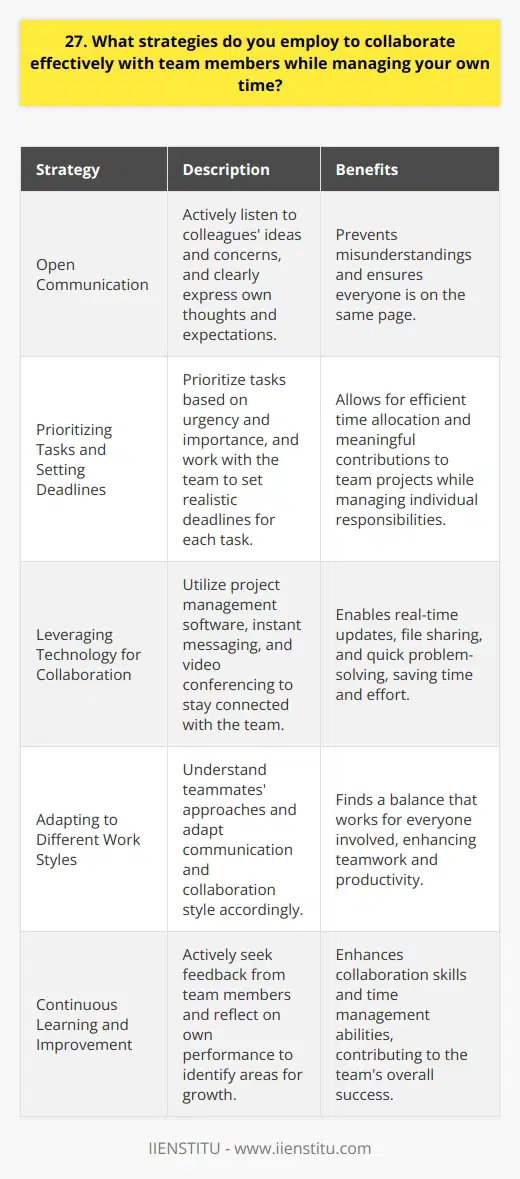
28. How do you handle situations where you have to make trade-offs between different tasks or projects?
When faced with trade-offs between tasks or projects, I prioritize based on urgency, impact, and alignment with goals. I assess which tasks are most critical and time-sensitive, and tackle those first.
Communicating with Stakeholders
I proactively communicate with my manager and relevant stakeholders about competing priorities. We discuss the trade-offs and decide together how to balance short-term needs with long-term objectives. Keeping an open dialogue ensures everyone stays informed.
Maximizing Efficiency
To handle multiple projects, I look for ways to work smarter. I break tasks into manageable chunks and delegate when possible. Leveraging tools like project management software helps me stay organized and on track.
Staying Agile
I've learned to stay flexible, because priorities can shift unexpectedly. When changes arise, I quickly adapt my plan and communicate any adjustments. Being agile allows me to keep projects moving forward.
Learning from Experience
With each project, I gain insights that inform my future approach. I reflect on what trade-offs I made and the outcomes. This helps me make even better decisions the next time I'm balancing competing demands.
In the end, I aim to make trade-offs that drive the most value for the business. It's a challenging part of the job, but I've developed strategies to navigate it effectively. I'm always striving to improve how I manage these situations.
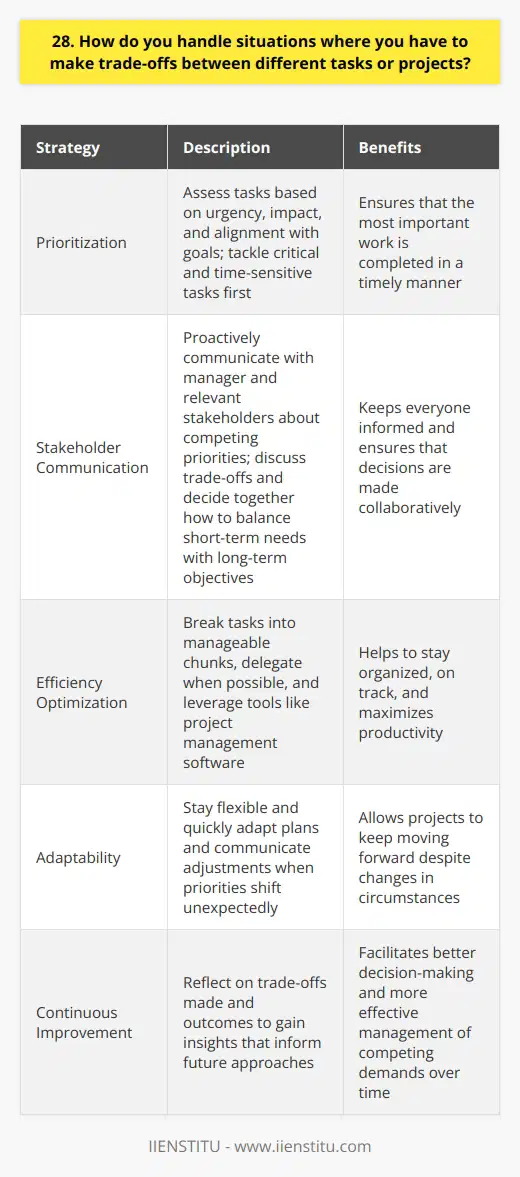
29. What techniques do you use to stay motivated and maintain momentum throughout the day?
To stay motivated and maintain momentum throughout the day, I rely on several proven techniques. First and foremost, I set clear, achievable goals for myself each morning. Breaking down larger tasks into smaller, manageable steps helps me stay focused and energized.
Prioritizing Self-Care
I also prioritize self-care, ensuring that I get enough sleep, eat nutritious meals, and take regular breaks. When I feel refreshed and well-rested, it's easier to tackle challenges with a positive attitude.
Embracing a Growth Mindset
Embracing a growth mindset is another key strategy. I view obstacles as opportunities for learning and growth, rather than setbacks. This perspective helps me stay resilient and adaptable in the face of change.
Celebrating Small Wins
Throughout the day, I make a point to celebrate small wins and accomplishments. Recognizing progress, no matter how small, boosts my confidence and keeps me motivated to keep pushing forward.
Surrounding Myself with Positivity
Finally, I surround myself with positive, supportive people who inspire and encourage me. Their energy is contagious and helps me maintain a can-do attitude, even during challenging times.
By implementing these techniques consistently, I'm able to stay motivated, focused, and productive, no matter what the day brings.
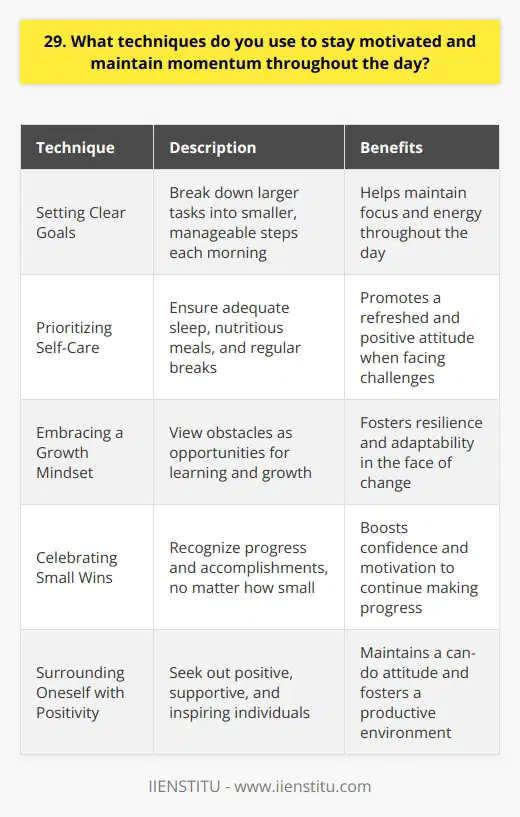
30. How do you adapt your time management approach to different work environments or project types?
As someone who has worked in various industries and on diverse projects, I've learned to be adaptable with my time management approach. In fast-paced environments like startups, I prioritize tasks ruthlessly and focus on delivering quick wins. For complex projects with longer timelines, such as in enterprise software development, I break down the work into manageable milestones and set interim deadlines to stay on track.
Tailoring Time Management to the Team
I also adjust my methods based on the team I'm working with. When collaborating with remote colleagues across time zones, I rely heavily on asynchronous communication and detailed documentation to keep everyone aligned. In contrast, when I'm in the office with my team, I prefer face-to-face standups and whiteboarding sessions to quickly sync up and resolve blockers.
Staying Flexible Yet Focused
No matter the environment or project type, I've found that the key is to stay flexible yet focused. I regularly reassess my priorities, communicate proactively with stakeholders, and course-correct as needed. At my last job, when a high-priority customer escalation came in, I quickly pivoted my attention to resolve the issue while ensuring my other projects stayed on track by delegating tasks and rescheduling non-critical meetings.
The Art of Adaptability
Ultimately, effective time management is both an art and a science. It requires a personalized mix of tools, techniques, and intuition honed through experience. I'm always experimenting with new approaches, from time-blocking to Pomodoro timers, to find what works best for me and my team. The goal is not perfection, but continuous improvement in making the most of our limited time and energy.
